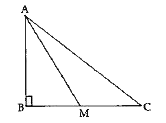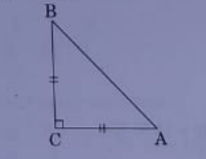P and Q are the mid-points of the CA and CD respectively of a triangle ABC, right angled at C. Prove that: 4AQ2=4AC2+ BC2, 4BP2=4BC2+AC2, and 4(AQ2+ BP2)=5AB2.
To solve the problem, we will follow the steps outlined in the video transcript and provide a detailed explanation for each part of the proof.
Given:
- Triangle ABC is right-angled at C.
- P and Q are the midpoints of CA and CD, respectively.
To Prove:
1. 4AQ2=4AC2+BC2
2. 4BP2=4BC2+AC2
3. 4(AQ2+BP2)=5AB2
Step 1: Proving 4AQ2=4AC2+BC2
1. Identify Triangle AQC: Since triangle ABC is right-angled at C, triangle AQC is also right-angled at C.
2. Apply Pythagoras Theorem: According to the Pythagorean theorem:
AQ2=AC2+QC2
3. Multiply by 4:
4AQ2=4AC2+4QC2
4. Express QC in terms of BC: Since Q is the midpoint of CD, we have QC=12BC. Therefore:
QC2=(12BC)2=14BC2
5. Substituting QC into the equation:
4AQ2=4AC2+4(14BC2)=4AC2+BC2
6. Conclusion: Thus, we have proved:
4AQ2=4AC2+BC2(Equation 1)
Step 2: Proving 4BP2=4BC2+AC2
1. Identify Triangle BPC: Triangle BPC is also right-angled at C.
2. Apply Pythagoras Theorem: According to the Pythagorean theorem:
BP2=BC2+CP2
3. Multiply by 4:
4BP2=4BC2+4CP2
4. Express CP in terms of AC: Since P is the midpoint of CA, we have CP=12AC. Therefore:
CP2=(12AC)2=14AC2
5. Substituting CP into the equation:
4BP2=4BC2+4(14AC2)=4BC2+AC2
6. Conclusion: Thus, we have proved:
4BP2=4BC2+AC2(Equation 2)
Step 3: Proving 4(AQ2+BP2)=5AB2
1. Add Equations 1 and 2:
4AQ2+4BP2=(4AC2+BC2)+(4BC2+AC2)
Simplifying this gives:
4AQ2+4BP2=4AC2+5BC2+AC2=5AC2+5BC2
2. Factor out the common term:
4(AQ2+BP2)=5(AC2+BC2)
3. Use Pythagorean Theorem: In triangle ABC, since it is right-angled at C:
AB2=AC2+BC2
4. Substituting into the equation:
4(AQ2+BP2)=5AB2
5. Conclusion: Thus, we have proved:
4(AQ2+BP2)=5AB2
Final Conclusion:
All three parts have been proved successfully.
- Triangle ABC is right-angled at C.
- P and Q are the midpoints of CA and CD, respectively.
1. 4AQ2=4AC2+BC2
2. 4BP2=4BC2+AC2
3. 4(AQ2+BP2)=5AB2
2. Apply Pythagoras Theorem: According to the Pythagorean theorem:
AQ2=AC2+QC2
3. Multiply by 4:
4AQ2=4AC2+4QC2
4. Express QC in terms of BC: Since Q is the midpoint of CD, we have QC=12BC. Therefore:
QC2=(12BC)2=14BC2
5. Substituting QC into the equation:
4AQ2=4AC2+4(14BC2)=4AC2+BC2
6. Conclusion: Thus, we have proved:
4AQ2=4AC2+BC2(Equation 1)
2. Apply Pythagoras Theorem: According to the Pythagorean theorem:
BP2=BC2+CP2
3. Multiply by 4:
4BP2=4BC2+4CP2
4. Express CP in terms of AC: Since P is the midpoint of CA, we have CP=12AC. Therefore:
CP2=(12AC)2=14AC2
5. Substituting CP into the equation:
4BP2=4BC2+4(14AC2)=4BC2+AC2
6. Conclusion: Thus, we have proved:
4BP2=4BC2+AC2(Equation 2)
4AQ2+4BP2=(4AC2+BC2)+(4BC2+AC2)
Simplifying this gives:
4AQ2+4BP2=4AC2+5BC2+AC2=5AC2+5BC2
2. Factor out the common term:
4(AQ2+BP2)=5(AC2+BC2)
3. Use Pythagorean Theorem: In triangle ABC, since it is right-angled at C:
AB2=AC2+BC2
4. Substituting into the equation:
4(AQ2+BP2)=5AB2
5. Conclusion: Thus, we have proved:
4(AQ2+BP2)=5AB2
All three parts have been proved successfully.
Topper's Solved these Questions
Similar Questions
ABC is a isosceles right angled triangle, right angled at C. prove that AB2=2AC2
View SolutionABC is a triangle, right angled at B, M is a point on BC. Prove that :
AM2+BC2=AC2+BM2

View Solutionin figure, ABC is an isosceles traingle, right angled at C. therefore

a) AB2=2AC2
b) BC2=2AB2
c) AC2=2AB2
d) AB2=4AC2
View SolutionP and Q are points on the sides AB and AC respectively of a △ABC. If AP= 2cm, PB = 4cm AQ= 3cm and QC= 6cm. Show that BC= 3PQ.
View SolutionIn Fig. 3, ABC is a right triangle, right angled at C and D is the mid-point of BC. Prove that AB2=4AD2−3AC2.
View SolutionIn any triangle ABC, prove that AB2+AC2=2(AD2+BD2) , where D is the midpoint of BC.
View SolutionIn a right triangle ABC, right angled at A, AD is drawn perpendicular to BC. Prove that:
AB2−BD2=AC2−CD2
View SolutionIn an equilateral triangle ABC, BE is perpendicular to side CA. Prove that:
AB2+BC2+CA2=4BE2
View SolutionIn Figure 2,AD⊥BC. Prove that AB2+CD2=BD2+AC2.
View SolutionABC is a triangle in which AB = AC and D is any point on BC. Prove that:
AB2−AD2=BD.CD
View Solution
